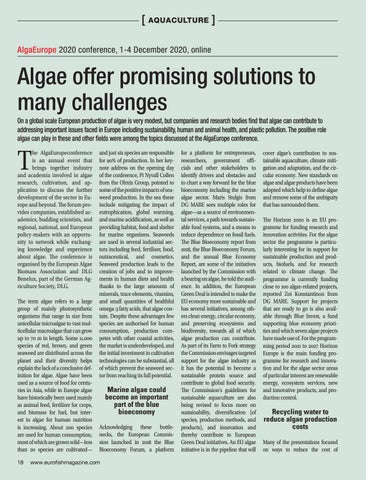[ AQUACULTURE ] AlgaEurope 2020 conference, 1-4 December 2020, online
Algae offer promising solutions to many challenges On a global scale European production of algae is very modest, but companies and research bodies find that algae can contribute to addressing important issues faced in Europe including sustainability, human and animal health, and plastic pollution. The positive role algae can play in these and other fields were among the topics discussed at the AlgaEurope conference.
T
he AlgaEuropeconference is an annual event that brings together industry and academia involved in algae research, cultivation, and application to discuss the further development of the sector in Europe and beyond. The forum provides companies, established academics, budding scientists, and regional, national, and European policy-makers with an opportunity to network while exchanging knowledge and experience about algae. The conference is organised by the European Algae Biomass Association and DLG Benelux, part of the German Agriculture Society, DLG. The term algae refers to a large group of mainly photosynthetic organisms that range in size from unicellular microalgae to vast multicellular macroalgae that can grow up to 70 m in length. Some 11,000 species of red, brown, and green seaweed are distributed across the planet and their diversity helps explain the lack of a conclusive definition for algae. Algae have been used as a source of food for centuries in Asia, while in Europe algae have historically been used mainly as animal feed, fertilizer for crops, and biomass for fuel, but interest in algae for human nutrition is increasing. About 200 species are used for human consumption, most of which are grown wild—less than 20 species are cultivated—
and just six species are responsible for 90 of production. In her keynote address on the opening day of the conference, Pi Nyvall Collen from the Olmix Group, pointed to some of the positive impacts of seaweed production. In the sea these include mitigating the impact of eutrophication, global warming, and marine acidification, as well as providing habitat, food and shelter for marine organisms. Seaweeds are used in several industrial sectors including feed, fertiliser, food, nutraceutical, and cosmetics. Seaweed production leads to the creation of jobs and to improvements in human diets and health thanks to the large amounts of minerals, trace elements, vitamins, and small quantities of healthful omega-3 fatty acids, that algae contain. Despite these advantages few species are authorised for human consumption, production competes with other coastal activities, the market is underdeveloped, and the initial investment in cultivation technologies can be substantial, all of which prevent the seaweed sector from reaching its full potential.
Marine algae could become an important part of the blue bioeconomy Acknowledging these bottlenecks, the European Commission launched in 2018 the Blue Bioeconomy Forum, a platform
XXX FVSPlTINBHB[JOF DPN
for a platform for entrepreneurs, researchers, government officials and other stakeholders to identify drivers and obstacles and to chart a way forward for the blue bioeconomy including the marine algae sector. Maris Stulgis from DG MARE sees multiple roles for algae—as a source of environmental services, a path towards sustainable food systems, and a means to reduce dependence on fossil fuels. The Blue Bioeconomy report from 2018, the Blue Bioeconomy Forum, and the annual Blue Economy Report, are some of the initiatives launched by the Commission with a bearing on algae, he told the audience. In addition, the European Green Deal is intended to make the EU economy more sustainable and has several initiatives, among others clean energy, circular economy, and preserving ecosystems and biodiversity, towards all of which algae production can contribute. As part of its Farm to Fork strategy the Commission envisages targeted support for the algae industry as it has the potential to become a sustainable protein source and contribute to global food security. The Commission’s guidelines for sustainable aquaculture are also being revised to focus more on sustainability, diversification (of species, production methods, and products), and innovation and thereby contribute to European Green Deal initiatives. An EU algae initiative is in the pipeline that will
cover algae’s contribution to sustainable aquaculture, climate mitigation and adaptation, and the circular economy. New standards on algae and algae products have been adopted which help to define algae and remove some of the ambiguity that has surrounded them. The Horizon 2020 is an EU programme for funding research and innovation activities. For the algae sector the programme is particularly interesting for its support for sustainable production and products, biofuels, and for research related to climate change. The programme is currently funding close to 100 algae-related projects, reported Zoi Konstantinou from DG MARE. Support for projects that are ready to go is also available through Blue Invest, a fund supporting blue economy priorities and which seven algae projects have made use of. For the programming period 2021 to 2027 Horizon Europe is the main funding programme for research and innovation and for the algae sector areas of particular interest are renewable energy, ecosystem services, new and innovative products, and production control.
Recycling water to reduce algae production costs Many of the presentations focused on ways to reduce the cost of














